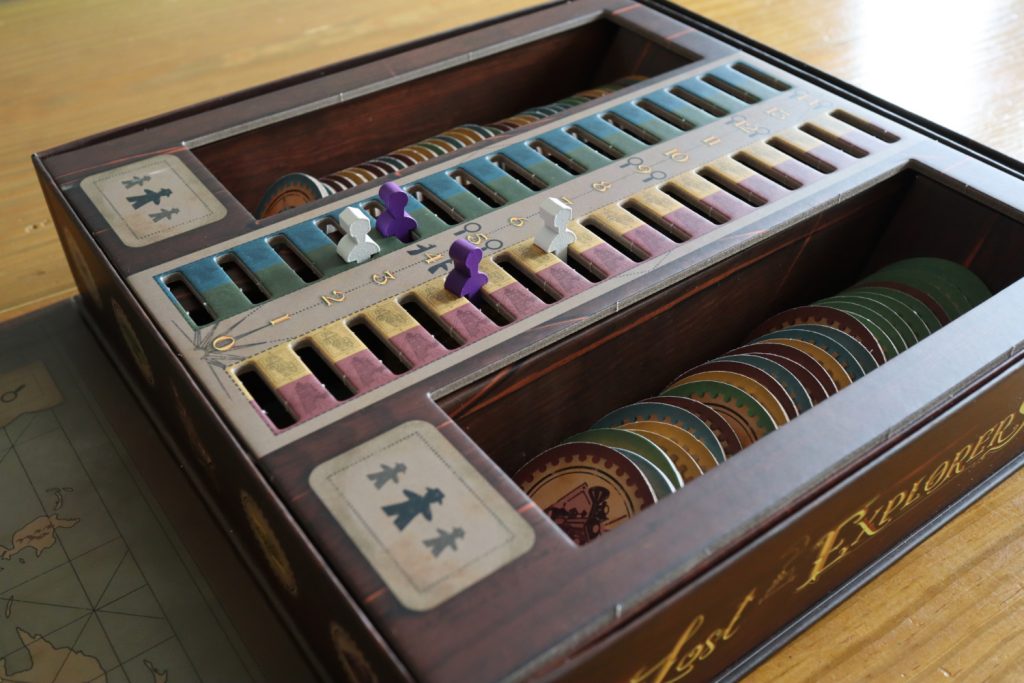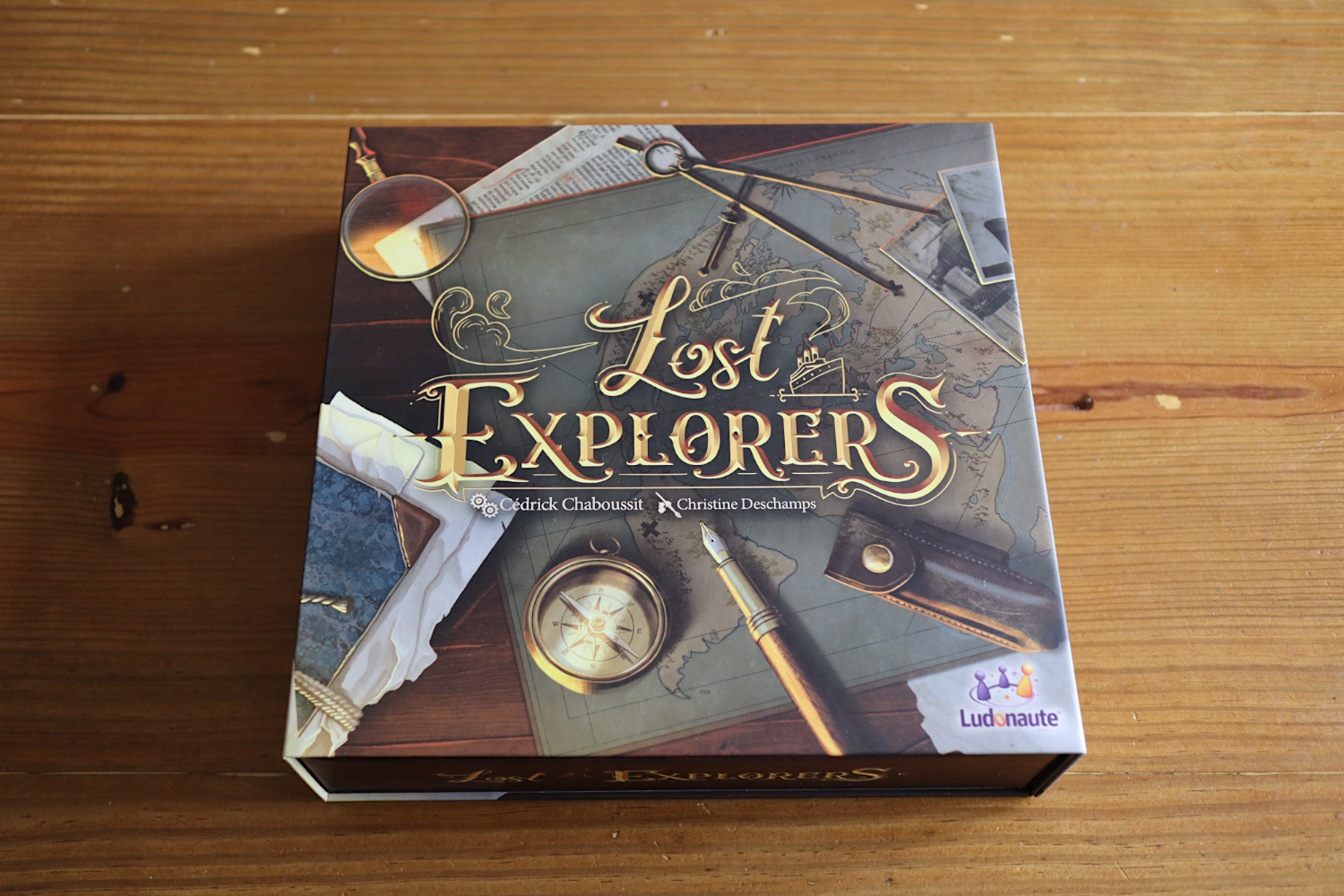Lost Explorers is the brand new adventure themed set collection board game from Ludonaute. Designed by Cédrick Chaboussit, featuring artwork from Christine Deschamps, the game sees 2 – 4 players using the right mixes of transport to get around the globe. Sending team members by boat, blimp and more the players are searching for clues of the Lost World. However, is this set to be part of your collection? Let’s find out!
Setup is extremely fast with the box placed in the middle of the table, and the world map revealed by opening the box. Depending on the player count a range of locations are marked with Validated Location tokens, effectively limiting the amount of visitable locations as the player count decreases. With the vehicle/mission tokens shuffled they are evenly split between the two transport areas in the box.
Each player takes a starting vehicle token of each colour, choosing one of them to be a mission – flipping it over to reveal the mission. Players also take the 4 expedition member meeples and 2 expedition leaders in their chosen colour. The leaders are used track the players’ discoveries on the two tracks in the box, with 3 of the 4 expedition meeples available to the player from the start of the game.
On a turn the active player follows two phases, effectively prep and missions. At the start of phase 1 a player is free to recall any expedition members from around the globe. Available meeples can then be either used to gain vehicle/mission tokens or sent out to locations on the world board. Up to two tokens can be gained on a turn, one from each of the two transport areas of the box. By sending a single meeple to a transport area the player gains the first token in the area. By sending two meeples to the same area they instead take the second token from the transport area and so on. Regardless of the tokens that are gained the player must instantly choose whether to take them as transport tokens or as missions to complete – with no way to reverse this decision later.
To send meeples out around the world players must use transport. The player must have all of the transport tokens in front of them as depicted on the routes from Venice. For example, the journey to St Basil’s in Moscow requires two trains. Once the meeple is placed the player chooses to discard one of the transport tokens used. A player can send out as many or as few of their meeples as they wish in this way on a turn, as long as they can afford to via transport tokens.

The mission phase is often ignored, as players build up their transport tokens and slowly deploy meeples around the globe. Players won’t just be sending meeples to random locations, instead choosing them based on the locations depicted on their mission tokens. At the end of any turn a player can choose to complete missions. If the player has a meeple at each location denoted on a mission token (not needing one there if it’s blocked by a Validated Location token) the player can complete it. To do so they must retrieve one of their meeples from the world board at one of the indicated locations. A player can complete as many missions as they wish, each time retrieving a meeple.
Depending on the colour of the mission token the player moves their associated expedition leader up the discovery track. Players have a red/yellow and a blue/green leader. Whenever the player moves their leader that is behind or equal to their other leader on discovery track they get to take a transport token from the communal discard pile. Players are also able to unlock a fourth meeple by pushing both leaders past 4 on the tracks.
After this the completed mission token(s) are flipped over and put it into the discard pile. Moving up the discovery track is the way to obtain clues, which is the key to victory. Players move up the tracker by the number of locations on the completed mission token, with clue symbols marked along the tracks at various intervals. When a leader passes these symbols the player gains a clue token, with the aim to get to four fastest.
Part of the allure of Lost Explorers is the back page of the rulebook being covered in QR codes. Being the first to 4 clues means you win and are able to scan one, based on the sum of the numbers on their clue tokens. Alas, this is a somewhat underwhelming ending to the game. While these direct the players to real world Google Maps locations, each time playing everyone around the table was certainly hoping for a bit more. Still, it does bring up some very interesting and stunning looking locations from around the world.

Lost Explorers is very much a family weight game, with simple turns and light choices. This doesn’t mean that choices don’t matter. Players can send meeples out onto the board ahead of time but this limits the player’s ability to take the additional transport tokens they will need. Thanks to the way that only one of transport tokens from a required set is discarded, there are plenty of opportunities to combo meeple placement. These bigger turns add that bit extra to the experience, without making it more complicated for new or younger players.
From the way that the box opens out to reveal the board, to the way the transport tokens sit in the box, Lost Explorers was on track to having a wonderful production quality. There are a few misses though that make me question the choices, almost being over produced. The game board is attached to the box, being a fold out lid with a nice magnetic close. Unfortunately, this results in the board being slightly on the small side. It would have been much clearer enlarged on a standard separate board. Then, the rest of the box is used for when players draw tokens from. The issue here is that after a number have been taken the tokens slip down in the box. The order of the tokens matters and when dropped down they aren’t easily visible from all angles – turning what seemed a great integrated design into a minor but not game breaking nuisance.
The variety from one game to the next comes from the order tokens can be drawn and which tokens players choose to take as missions and not transport. Despite needing to potentially send meeples to different locations around the globe, the game doesn’t ever really feel different. Playing back to back the game could therefore become a little stale – though with a playtime of 30 minutes it doesn’t outstay its welcome. Varying up the Validated Locations slightly helps this but it’s not possible in a 2 player game.
Lost Explorers is a game aimed towards a family audience. There is a simple aim each turn, though choices are available to you. Collecting the sets of tokens and then getting the meeples sent to the right locations is intuitive. A lot of the experience revolves around getting the tokens you need and which you choose to turn over for missions. The issue with this is a game can be won by a player turning over a token to show a mission that nicely aligns with others they already have, whilst someone else gets no overlap whatsoever. That would stop the game hitting my table but in a family game night environment could allow all involved to have a chance of winning, leveling the playing field.
(Editor’s Note: Lost Explorers was provided to us by Asmodee for the review. The game is currently available from local board game stores! Find your local store here.)

